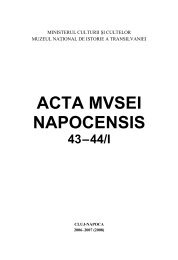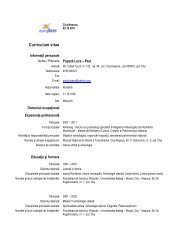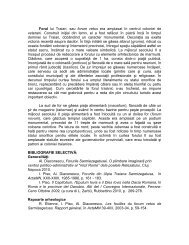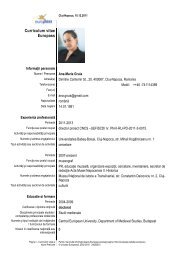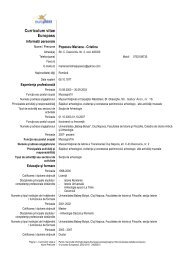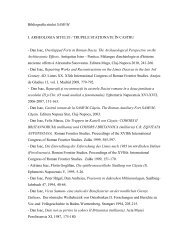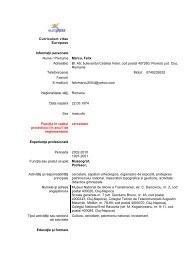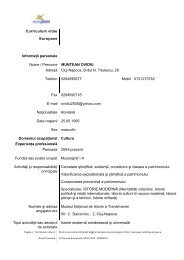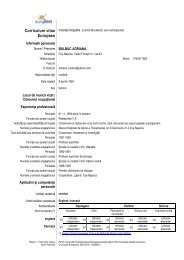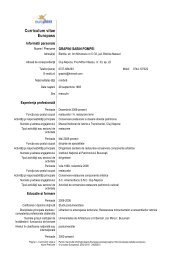41-42/I – Archeology - Muzeul Naţional de Istorie a Transilvaniei
41-42/I – Archeology - Muzeul Naţional de Istorie a Transilvaniei
41-42/I – Archeology - Muzeul Naţional de Istorie a Transilvaniei
Create successful ePaper yourself
Turn your PDF publications into a flip-book with our unique Google optimized e-Paper software.
8<br />
Gheorghe GâŃă, Alexandru Dragoman<br />
site, from Vădastra II layer 20 , we mention that in his book on the Neolithic and Copper<br />
Age houses in south-east Europe, Clemens Lichter assigned the house uncovered in the<br />
eponymous settlement to Datierungsgruppe 2, that is 5500-4700 CAL. BC 21 . On the<br />
basis of corroborating the data on the relative chonology and the existing radiocarbon<br />
data for other Neolithic sites at the Lower Danube, the Vădastra settlements were dated<br />
between 5200 and 4900 CAL. BC 22 .<br />
Analytical methods<br />
The present article is based on the tests performed on 1172 diagnostic sherds<br />
and fragmentary vessels selected by Mateescu from the excavations he conducted at<br />
Vădastra. They <strong>de</strong>rive both from the Neolithic layers, and from various i<strong>de</strong>ntified<br />
features. For the sake of comparison 43 figurines (9 from Vădastra I contexts and 34<br />
from Vădastra II contexts) have been also analysed 23 .<br />
The average thickness of the sherds was <strong>de</strong>termined by the value obtained as<br />
an arithmetic average of all the individual measurements ma<strong>de</strong> with the gauge, with a<br />
0.1 mm precision 24 . The porosity was <strong>de</strong>termined by a 24 hour water absorption and<br />
expressed in percentages as related to the initial weight of the pottery fragments.<br />
Two in<strong>de</strong>xes were calculated: the porosity in<strong>de</strong>x and the mo<strong>de</strong>lling one. The<br />
porosity in<strong>de</strong>x was calculated as a porosity/average sherd thickness ratio. It<br />
estimates the amount of vegetal mass ad<strong>de</strong>d to the paste. The mo<strong>de</strong>lling in<strong>de</strong>x was<br />
calculated as a standard <strong>de</strong>viation of the individual measurements of the average<br />
thickness, and is an estimation of the evenness of the thickness of the sherd walls.<br />
The results of the physical tests and of the in<strong>de</strong>xes were used for selecting the<br />
sherds for chemical tests, X-ray diffraction tests and infrared absorption tests. 138<br />
chemical tests were performed of some extracts in hydrochloric acid 6N treating one<br />
gram sample <strong>–</strong> thoroughly cut into pieces <strong>–</strong> with 20 ml hydrochloric acid. The solution<br />
was kept for an hour on boiling water by stirring from time to time, filtered<br />
immediately, and washed with 5 % hydrochloric acid until collecting 100 ml. magnesium,<br />
calcium, strontium and iron were dosed by atomic absorption. The X-ray<br />
diffraction patterns were obtained by always using the same conditions of the equipment.<br />
231 pottery samples and sources were broken up roughly and <strong>de</strong>posited on<br />
glass bla<strong>de</strong>s. The intensities of the lines from 4.26 KX (quartz) to 3.03 KX (calcite)<br />
were measured and the ratio of these lines was calculated. The infrared absorption<br />
analyses were performed by using the technique of the potassium bromi<strong>de</strong> disks at a<br />
dillution of 1 mg sample in 300 mg potassium bromi<strong>de</strong>. Kaolinite occurred in the case<br />
of 138 samples (out of 231). Clay fractions un<strong>de</strong>r 0.002 mm were separated from 14<br />
presumptive sources by dispersion in water with NaOH up to the pH 9 and their<br />
mineralogical composition was <strong>de</strong>termined by using orientated preparates 25 . Particle<br />
size analyses of the presumptive sources were carried out by the Khacinski<br />
method 26 .<br />
20<br />
Mateescu 1978, p. 65, footnote 9.<br />
21<br />
Lichter 1993.<br />
22<br />
Mantu 1999-2000, p. 101, table 2.<br />
23<br />
About some figurines found at Vădastra see Voinescu, Mateescu 1980; Mateescu, Voinescu 1982.<br />
For the use of white paint or ochre in <strong>de</strong>corating the figurines (and pottery) see GâŃă, Mateescu 1987;<br />
1992b; 1999-2001.<br />
24<br />
GâŃă et al. 1997.<br />
25 GâŃă 1972.<br />
26 MoŃoc 1964.



